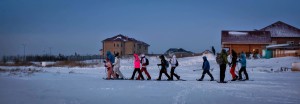GAITHERSBURG, MD – In Astana’s six months of winter, a hardy few have decided to embrace their flat, cold, powdery environs and take up an activity that seems made for the steppe – snowshoeing.
Paul Kenul of Plainview, New York, began snowshoeing in Astana as winter fell in 2012, first with friends from the U.S. Embassy in Astana, where he works, and then with a growing group of outdoor adventurers who gathered through word of mouth. The group hiked through the steppe summer and when winter 2013 rolled around, some of the summer hikers decided to try snowshoeing. The group has kept the practice up ever since, and the free-form hikes have since been organised into a coordinated group, the Astana Outdoor Adventure club (AOA).
Kenul had not been a snowshoeing enthusiast before trying it in Astana; rather, he remembered disliking it the one time he’d tried it years before in Alaska. “Back then, we used cumbersome steel tennis-racket-looking snowshoes that were awkward to walk on,” he told The Astana Times on Jan. 22. But a visiting friend told him that snowshoes had changed and were completely different – and a lot more fun – nowadays. “He promised I would not be disappointed.” Kenul ordered a pair of snowshoes from the United States. “[H]e was right. It was a blast. Word spread.”
The AOA eventually organised a “Snowshoeing Social” in October 2013, which drew 80 people.
The initial group of snowshoers was primarily expatriates and local employees of organisations employing expatriates, mainly embassies, international companies and schools, Kenul said. The number of snowshoers doesn’t match the number of Astana-ites who join the AOA group’s summer hikes, but they are growing.
That doesn’t mean that snowshoeing in Astana’s sometimes frigid temperatures is an easy sell. “There is a chutzpah factor in snowshoeing,” Kenul said. “You are doing what virtually no one else dares to do. You are getting out in extreme elements and visiting places that are inaccessible without the gear. The views and landscapes are awe-inspiring.”
“Snowshoeing is great because it extends the hiking season and, in many ways, intensifies everything that’s good about being outdoors,” Linda Tailleur of Gatineau, Quebec, told The Astana Times on Jan. 23. Tailleur has been in Astana for about a year and a half and is a frequent participant in AOA events. “Really, the exhilaration that hikers get from all the fresh air and the amazing scenery they take in is enhanced by the cold air and white terrain.”
For snowshoeing outings, the group generally heads north to Akkol or Schuchinsk and Borovoye, Kenul said, but there are points in-between they look forward to discovering. “[W]e plan to make a trip to Zerendy this winter, and other-lesser known places. The Yereymentau hills provide some exciting places to go snowshoeing.”
Deeply cold temperatures are to be expected in this region in the winter. They’re sometimes even part of the fun, Kenul said. “Some of our best snowshoeing experiences have been at extremely cold temperatures in the range of -20 C to -30 C. At these temperatures, the air has less humidity and it is more comfortable than snowshoeing at -10 C. As it gets colder, the snow also becomes drier and fluffier, which decreases flotation for a given surface area of the snowshoe.” Flotation is the effect created by distributing weight across the snowshoes, which are much larger than the size of a person’s foot.
In Astana, growing but still small, and with a relatively small population of foreigners, the snowshoeing trips and the recovery in regional cafes afterward can become a significant social activity – and an opportunity to explore areas outside the city. “Isn’t it true that stepping indoors is never so good as when you’ve been out in the rain or the cold? The indoors may be a home warmed by a fireplace or a rickety café in the countryside warmed by the AOA crowd. Either way, the pleasure is somehow compounded by the fact that we are coming in from the cold,” said Tailleur. And “half the fun is bragging about our exploits afterwards in a small town café,” Kenul said.
And exploits they are. “Snowshoeing burns a significant amount of calories (between 500 and 800 per hour, depending on conditions),” Kenul said. “If you like to eat, a good balance is snowshoeing. It provides tremendously good workout for the legs, abdomen, and back. Much like cross-country skiing, it has a sculpting effort on the legs, gluts and torso. It can be so intense that you get a runner’s high.”
Kenul admits that he hasn’t yet convinced all of AOA’s enthusiastic summer hikers to give snowshoeing a try, but he’s still hoping. The organisation’s website, with pictures of recent snowshoeing events, is getting thousands of hits, he said. With another couple months of snow ahead of Astana, they may convince a few more people to strap on snowshoes.



